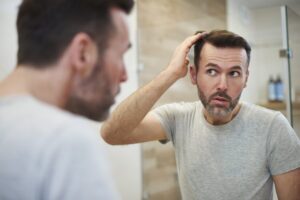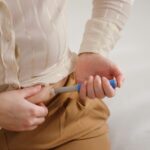Medical Review by Jennie Stanford, MD, FAAFP, DABOM
Summary:
- Finasteride is primarily used to treat male pattern balding by reducing DHT levels, It can also help manage benign prostatic hyperplasia (BPH) and may lower prostate cancer risk.
- There are no significant safety concerns with combining alcohol and finasteride. Dizziness may occur in some individuals—but this is because it’s a potential side effect of both drugs, not necessarily because they’re interacting.
- Drinking alcohol responsibly should not reduce finasteride’s effectiveness for hair loss, but heavy drinking may affect its ability to lower the risk of prostate cancer.
- Safe drinking practices include avoiding heavy drinking, staying hydrated, and listening to your body’s reactions. This is good advice whether you’re taking finasteride or not.
- Consult your healthcare provider if alcohol worsens your hair loss or prostate symptoms or if you’re unsure how much alcohol is safe while taking finasteride.
Here’s how drinking can change the effects of finasteride
Many men take finasteride as a hair loss treatment, but it’s important to know how a new medicine could affect your lifestyle and routines before you start taking it. Knowing whether you’ll have to adjust your routines or give up certain activities can help you make important decisions with your healthcare provider about finasteride and other drugs.
One of the most common questions we get at Lemonaid Health is whether you’ll still be able to drink alcohol while taking finasteride for male pattern balding. And while the short answer is yes, you can, there are a few details you should consider before mixing these two substances. Below, we explain what you need to know.
Quick finasteride facts: what it does & how it works
Finasteride impacts your body in several different ways. Here’s a quick overview of the main effects:
Treating hair loss
Finasteride is primarily used to treat androgenic alopecia, also known as male pattern balding. It works by blocking the hormone DHT (dihydrotestosterone) which activates the androgen receptors responsible for shrinking hair follicles and leading to hair loss.
By reducing DHT levels, finasteride prevents your androgen receptors from becoming activated and stops them from impacting the way your hair grows. This helps to slow hair loss and promotes regrowth in some cases.
Learn more: Finasteride guide: uses, benefits, side effects, & more
Managing prostate problems
In addition to treating hair loss, finasteride is also used to manage benign prostatic hyperplasia (BPH), a condition that causes an enlarged prostate. Lowering your DHT levels causes your prostate to shrink, which reduces pressure on your urethra.
That means if you’re taking finasteride for BPH, you might have less difficulty urinating or have to urinate less often. This can help make you more comfortable and allow you to sleep through the night without having to get up and use the bathroom.
Reducing prostate cancer risk
Some studies have shown that finasteride may help lower the risk of developing prostate cancer in men. Specifically, long-term use of finasteride has been found to reduce the relative risk of prostate cancer by up to 30%, making it a potential option for men at higher risk of the disease.
Combining alcohol & finasteride
Finasteride can be useful for many men—but if you’re going to enjoy a few drinks while you’re taking this medication, there are a few things you should keep in mind. Here’s what to know beforehand.
General safety
There are no known interactions between finasteride and alcohol, and none listed in the patient information for Propecia® (a branded form of finasteride). If you’re taking finasteride, you can generally expect the same impact from alcohol that you would normally experience.
Mixing finasteride and alcohol typically does not cause any additional issues beyond the health effects associated with drinking alcohol alone. That means there’s no significant interaction between these substances that should make drinking riskier.
Some people may experience dizziness when combining finasteride with alcohol, but this isn’t necessarily due to an interaction between these drugs—it’s simply one of the possible side effects of both finasteride and excessive drinking. As with any medication, individual responses may vary.
Efficacy for hair loss
There’s currently no evidence showing that drinking alcohol responsibly while taking finasteride makes it less effective as a treatment for hair loss. That means you should still be able to experience the benefits of finasteride for slowing hair loss and promoting regrowth even if you drink occasionally.
Learn more: 8 ways you can reduce or stop hair loss
Impact on prostate cancer risk
However, some studies have found that heavy drinking while on finasteride can impact its ability to reduce prostate cancer risk. Men who consume large amounts of alcohol (over 50g per day or over 4 drinks per day on at least 5 days per week) may not experience the same protective effects of finasteride when it comes to lowering their risk for prostate cancer.
Drinking alcohol has also been linked to many kinds of cancer—including cancer of the prostate, liver, colon, rectum, esophagus, and other organs. So, whether you’re taking finasteride for prostate health or not, it’s always a good idea to limit heavy drinking.
Safe practices for drinking alcohol while taking finasteride
Here are some best practices to follow if you plan to drink alcohol while using finasteride:
- Avoid heavy drinking: Drinking less (or not at all) is healthier than drinking more.
- Stay hydrated: Some research suggests that drinking water may actually help reduce alcohol cravings.
- Listen to your body: If you experience nausea or any other side effects of alcohol poisoning, stop drinking and consider cutting back on the amount you drink in the future.
When to consult your healthcare provider
It’s always a good idea to speak with your healthcare provider about any concerns you have regarding alcohol and medication. Here are a few situations where we recommend seeking medical advice:
- If you experience severe nausea or vomiting after drinking alcohol while taking finasteride.
- If you notice that your symptoms of hair loss or prostate problems are getting worse after consuming alcohol.
- If you drink alcohol regularly and are concerned about its impact on your prostate.
- If you are unsure about how much alcohol is safe to consume while on finasteride.
Learn more about finasteride with Lemonaid Health
The more you know about how finasteride works, the easier it is to prepare for using this medication and avoid unexpected complications. Always consult a healthcare provider before you start finasteride, and check in with them if you notice anything unusual (even if alcohol isn’t involved).
While drinking alcohol responsibly doesn’t cause additional problems for most finasteride users, heavy drinking might make it less effective at protecting you from the risk of prostate cancer—and can increase your risk of other cancers as well. Make sure you understand these risks so you and your provider can make the best decisions to support your health.
Lemonaid Health can help by connecting you with US-based medical professionals online. We make it easy to have your questions about alcohol and finasteride answered by experts, and can also provide finasteride prescriptions in clinically indicated cases. Get started today to find the right hair loss treatment plan for you.
Propecia® is a registered trademark of Johnson & Johnson.












